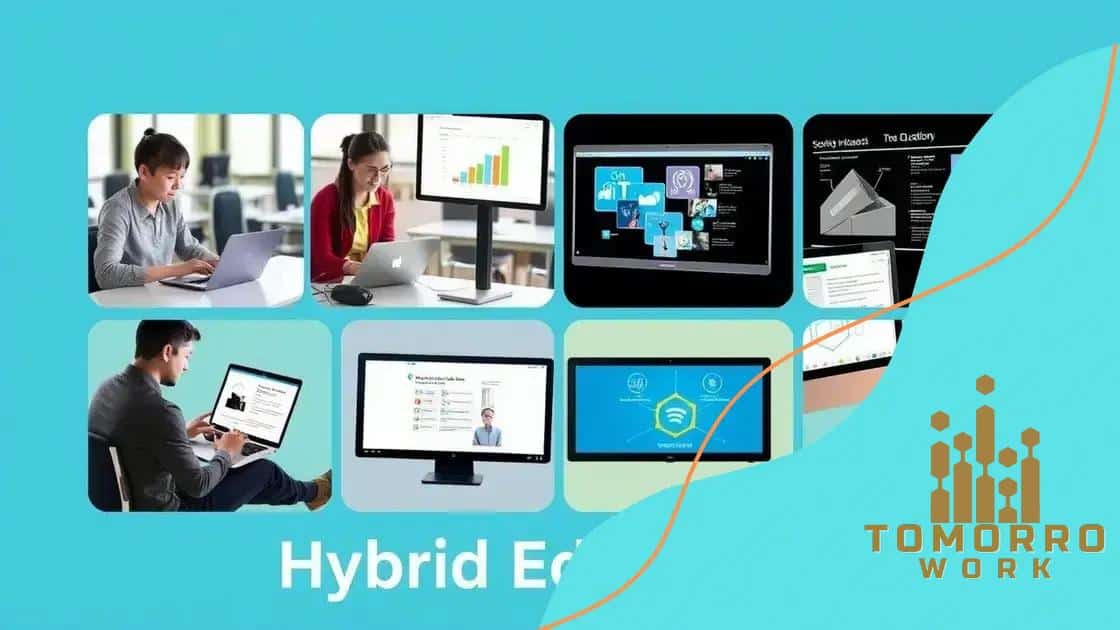How hybrid learning models are changing college classrooms

Advertisements
Hybrid learning models are transforming college classrooms by blending online and in-person education, offering flexibility, personalized learning, and access to diverse resources while addressing challenges such as technology access and student engagement.
How hybrid learning models are changing college classrooms offers an exciting glimpse into a new era of education. Imagine attending lectures from anywhere while still engaging with peers and instructors in real-time. This approach is reshaping how we learn and connect in college.
Advertisements
Understanding hybrid learning models
Understanding hybrid learning models is essential as education continues to evolve. These models blend traditional classroom techniques with online learning methods, creating a dynamic environment for students.
In hybrid learning, the focus is on flexibility. Students benefit from both face-to-face interactions and digital resources. This approach encourages independence and personal responsibility in learning.
Key Features of Hybrid Learning Models
Hybrid models typically include the following:
Advertisements
- In-person classes that allow direct interaction with teachers.
- Online courses that provide access to diverse materials and resources.
- Flexible scheduling for students to learn at their own pace.
- Use of technology to enhance learning experiences.
Many colleges are adopting these models to cater to various learning styles. For example, some students may prefer the visual and auditory components of online lessons, while others may thrive in hands-on group activities.
Furthermore, hybrid learning positions educators to address individual student needs more effectively. With digital tools, teachers can track progress and provide tailored support where necessary. This ensures that no student is left behind, promoting an inclusive learning environment.
Benefits of Hybrid Learning
Students in hybrid settings often experience increased motivation and engagement. They can access lectures and resources at times that are convenient for them, greatly improving their learning experience. Some advantages of hybrid learning include:
- Access to a wider range of materials and teaching methods.
- Improved collaboration opportunities among peers.
- Enhanced critical thinking and problem-solving skills.
As hybrid learning continues to gain popularity, it’s clear that these models are not just a trend—they are a powerful strategy for enhancing educational experiences. By combining the best of both worlds, hybrid learning is paving the way for a more adaptable and comprehensive educational future.
Benefits of hybrid learning for students
Benefits of hybrid learning for students are numerous and impactful. This model not only enhances the educational experience but also prepares students for real-world scenarios.
One major benefit is the flexibility that hybrid learning offers. Students can study at their own pace, balancing their academic demands with personal responsibilities. This flexibility allows them to manage their time more effectively, which can lead to improved academic performance.
Enhanced Access to Resources
Hybrid learning provides students with greater access to educational resources. With online components, they can explore a variety of materials beyond traditional textbooks. For instance:
- Students can watch recorded lectures anytime.
- They can participate in interactive online discussions.
- Access to digital libraries and databases expands research opportunities.
In a hybrid environment, learners gain the ability to tailor their educational experience to their needs. This personalization can significantly boost motivation and engagement.
Improved Collaboration
Another important advantage is the increase in collaboration among students. Hybrid learning encourages group projects that combine online discussions with in-person meetings. This fosters teamwork skills, a crucial asset in today’s job market. Students learn to communicate effectively, share ideas, and work towards common goals.
Moreover, hybrid learning often encourages the use of technology to enhance collaboration. Platforms like discussion forums and shared documents allow students to connect and collaborate efficiently.
As they engage in both physical and virtual interactions, students become more proficient in navigating digital environments. This skill will serve them well in future workplaces where online communication is integral.
Personal and Social Development
Hybrid learning also supports personal and social development. By participating in both online and face-to-face activities, students build strong relationships. They learn the value of diversity, as they interact with peers from various backgrounds.
This blended approach promotes emotional intelligence, adaptability, and resilience. Students become better equipped to handle challenges, whether they arise in academic settings or their future careers.
Technological tools enhancing hybrid education

Technological tools enhancing hybrid education play a crucial role in blending online and face-to-face learning. These tools not only facilitate communication but also create interactive and engaging learning experiences for students.
One of the most significant advantages of hybrid learning is the integration of various digital platforms. Tools like learning management systems (LMS) allow educators to organize course materials, track student progress, and deliver assessments. This streamlined approach helps students stay on track with their studies.
Interactive Learning Platforms
Interactive platforms are essential in keeping students engaged. For instance, tools such as Google Classroom and Moodle provide a collaborative environment. They enable teachers to share resources, lead discussions, and assign tasks with ease. Furthermore, these platforms foster communication among students, promoting a sense of community.
With these technologies, students can participate in real-time discussions, providing opportunities to ask questions and receive immediate feedback.
Video Conferencing Tools
Video conferencing tools like Zoom and Microsoft Teams have revolutionized how classes are conducted. These tools bring distant learners into the classroom, allowing for a rich, interactive experience. Students can see and hear their instructors in real-time, making the learning experience feel more personal.
Additionally, recorded sessions allow students to revisit lessons whenever necessary. This is especially beneficial for complex subjects where understanding may require multiple reviews.
Assessment and Feedback Tools
Assessing student performance is another essential aspect of hybrid education. Online quizzes, surveys, and feedback tools such as Kahoot! and Quizlet enable teachers to gauge understanding effectively. These tools provide immediate results and analytics, allowing educators to identify areas needing additional attention.
By using technology for assessments, teachers can adapt their teaching strategies based on real-time data. This personalized approach helps meet the diverse needs of students.
Ultimately, the integration of technology in hybrid education not only enhances learning experiences but also prepares students for a tech-savvy world. As these tools continue to evolve, they will further transform the educational landscape.
Challenges faced in hybrid classrooms
Challenges faced in hybrid classrooms can significantly affect both teaching and learning experiences. While hybrid models offer various benefits, they also present unique obstacles that educators and students must navigate.
One major challenge is ensuring equal access to technology. Not all students have reliable devices or internet connections at home. This digital divide can create disparities in learning opportunities, putting some students at a disadvantage. Schools must find ways to provide necessary resources or support to bridge this gap.
Maintaining Student Engagement
Another challenge is keeping students engaged in a hybrid setting. With some students attending remotely, it can be difficult for teachers to create an inclusive environment. In-person students may inadvertently dominate discussions, leaving online learners feeling disconnected. Educators need to employ strategies that encourage participation from all students, regardless of their location.
This can include using breakout groups, interactive polls, and other tools that promote collaboration. Teachers should be attentive to the dynamics of the classroom to ensure every voice is heard.
Balancing Assessment and Feedback
Assessing student performance also poses a challenge in hybrid classrooms. With a mix of online and in-person students, it can be difficult to develop fair assessment methods. Teachers must create assessments that accurately measure understanding while considering the different contexts students are learning in.
Feedback can also be more complicated in this setup. Teachers need to provide timely and constructive feedback through various channels, which can be overwhelming. Establishing clear guidelines and expectations for assessments can help alleviate some of these issues.
Lastly, managing classroom technology and ensuring that all students can connect and participate without technical difficulties is vital. Frequent issues with connectivity or software can distract students and disrupt the flow of lessons. Training for both teachers and students on the technologies used is beneficial in minimizing these disruptions.
Navigating these challenges is crucial for maximizing the benefits of hybrid education. Working together to overcome these obstacles can foster a more inclusive and effective learning environment for everyone involved.
Future trends in hybrid learning
Future trends in hybrid learning are shaping the next generation of education. As technology continues to evolve, so do the ways in which students engage with learning.
One significant trend is the increased use of artificial intelligence (AI) in education. AI tools can help personalize learning experiences. They analyze student data to identify strengths and weaknesses, providing tailored resources that meet individual needs. This personalized approach can greatly enhance student success.
Blended Learning Environments
Another emerging trend is the growth of blended learning environments. These combine online and in-person experiences seamlessly. In the future, classrooms may become more flexible, allowing students to choose when and how they learn best. This flexibility helps cater to diverse learning preferences and schedules.
- Combining synchronous (live) and asynchronous (recorded) sessions.
- Creating interactive learning spaces that promote collaboration.
- Utilizing project-based learning to foster real-world skills.
As blended environments become more common, educators will need ongoing training to adopt best practices. This training will ensure they maximize the potential of hybrid models.
Integration of Virtual and Augmented Reality
Another exciting trend is the integration of virtual reality (VR) and augmented reality (AR) in the classroom. These technologies allow students to experience immersive learning scenarios. For example, students can virtually explore historical sites or conduct science experiments in simulated environments.
These experiences can lead to deeper understanding and retention of knowledge. As schools invest in VR and AR technologies, the opportunities for innovative teaching will expand, making learning more engaging and impactful.
In addition, many institutions are prioritizing mental health and well-being. Hybrid learning models may incorporate wellness checks and support systems that cater to students’ emotional needs. This trend recognizes the importance of student well-being in achieving academic success.
Overall, as hybrid learning evolves, the focus will be on creating inclusive, engaging, and technology-rich education experiences. By embracing these trends, educators can better prepare students for the demands of a rapidly changing world.
In conclusion, hybrid learning is transforming the way education is delivered. It combines the best of both online and in-person learning, making it more flexible and engaging for students. As we move into the future, we can expect to see more technological advancements that enhance the learning experience. By addressing the challenges and embracing innovative tools, educators can create inclusive environments that meet diverse student needs. Ultimately, hybrid learning prepares students for a constantly changing world, equipping them with skills for the future.
\n\n\n
| Topic 🌟 | Details 📝 |
|---|---|
| Flexibility | Students can learn at their own pace and on their own schedule. |
| Engagement | Interactive tools keep students involved and motivated. |
| Technology Integration | Use of AI, VR, and AR enhances the learning experience. |
| Collaboration | Encourages teamwork through blended learning activities. |
| Preparation for the Future | Equips students with necessary skills for a changing world. |
\n
\n
FAQ – Frequently Asked Questions about Hybrid Learning Models
What are hybrid learning models?
Hybrid learning models combine online and in-person instruction, providing flexibility for students to learn in various environments.
What are the benefits of hybrid learning?
Benefits include increased flexibility, enhanced access to resources, improved collaboration opportunities, and personalized learning experiences.
What challenges do educators face in hybrid classrooms?
Challenges include ensuring equal access to technology, maintaining student engagement, balancing assessments, and managing classroom dynamics.
What future trends can we expect in hybrid education?
Future trends may include greater integration of AI and VR, more blended learning environments, and a focus on mental health and well-being in education.





